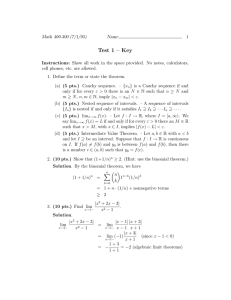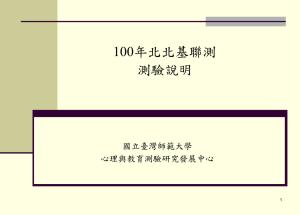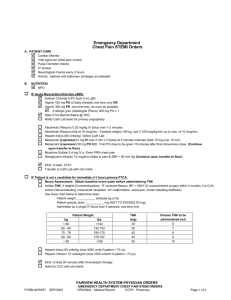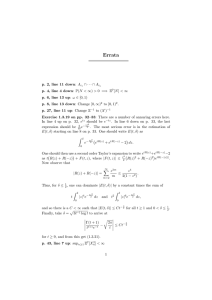Document 10821000
advertisement
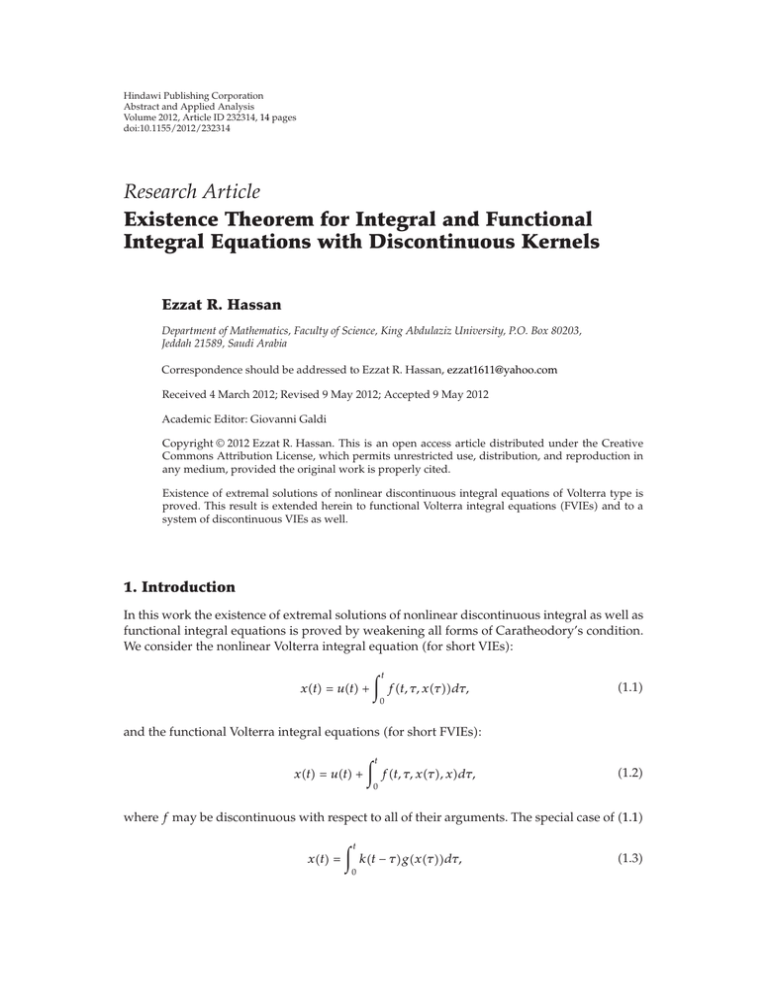
Hindawi Publishing Corporation
Abstract and Applied Analysis
Volume 2012, Article ID 232314, 14 pages
doi:10.1155/2012/232314
Research Article
Existence Theorem for Integral and Functional
Integral Equations with Discontinuous Kernels
Ezzat R. Hassan
Department of Mathematics, Faculty of Science, King Abdulaziz University, P.O. Box 80203,
Jeddah 21589, Saudi Arabia
Correspondence should be addressed to Ezzat R. Hassan, ezzat1611@yahoo.com
Received 4 March 2012; Revised 9 May 2012; Accepted 9 May 2012
Academic Editor: Giovanni Galdi
Copyright q 2012 Ezzat R. Hassan. This is an open access article distributed under the Creative
Commons Attribution License, which permits unrestricted use, distribution, and reproduction in
any medium, provided the original work is properly cited.
Existence of extremal solutions of nonlinear discontinuous integral equations of Volterra type is
proved. This result is extended herein to functional Volterra integral equations FVIEs and to a
system of discontinuous VIEs as well.
1. Introduction
In this work the existence of extremal solutions of nonlinear discontinuous integral as well as
functional integral equations is proved by weakening all forms of Caratheodory’s condition.
We consider the nonlinear Volterra integral equation for short VIEs:
xt ut t
ft, τ, xτdτ,
1.1
0
and the functional Volterra integral equations for short FVIEs:
xt ut t
ft, τ, xτ, xdτ,
1.2
0
where f may be discontinuous with respect to all of their arguments. The special case of 1.1
xt t
0
kt − τgxτdτ,
1.3
2
Abstract and Applied Analysis
has been studied extensively under continuity and/or monotonicity 1–4. Meehan and
O’Regan 5 established, by placing some monotonicity assumption on a nonlinear L1 Carathéodory kernel of the form kt, s, xs, existence of a C0, T solution to 1.1. It is
proven in 6 that, providing some type of discontinuous nonlinearities, 1.1 has extremal
solutions. Dhage 7 proved under mixed Lipschitz, Carathéodory, and monotonicity
conditions existence of extremal solutions of nonlinear discontinuous functional integral
equations. Other remarkable work was done in 8–11.
The main objective in this paper is to emphasize that the kernel f is not required to
be neither continuous nor monotonic in any of its arguments to establish an existence of
extremal solutions for 1.1 in R which generalizes in some aspects some of the previously
mentioned works. A monotonicity type condition with respect to the functional term is
needed to establish existence of extremal solutions to 1.2. We base the proof of the main
result on, among other tools, the following lemmas which could analogously be proved as
Lemma 1.1 and Lemma 1.2, see 12, and hence the proofs are omitted.
Lemma 1.1. Suppose that f : 0, 1 × 0, 1 × R → R satisfies conditions C1 and C3. Let
x1 , x2 : 0, 1 → R be continuous and satisfy the inequality x1 τ < x2 τ for all τ ∈ 0, 1. Then
the functions
ϕt, τ inf
y∈x1 τ,x2 t,τ
f t, τ, y ,
ψt, τ sup
f t, τ, y ,
y∈x1 τ,x2 τ
1.4
are Lebesgue measurable for each fixed t ∈ 0, 1. In particular, for each t ∈ 0, 1, ft, ·, x· is
Lebesgue measurable for each fixed x ∈ C0, 1.
Lemma 1.2. Suppose that f : 0, 1 × 0, 1 × R → R satisfies conditions C1, C2, and C3. Let
x1 , x2 : 0, 1 → R be continuous and satisfy the inequality x1 τ < x2 τ for all τ ∈ 0, 1. Let, for
each t, τ, x ∈ 0, 1 × 0, 1 × R,
f ∗ t, τ, x lim inf f t, τ, y ,
y↓x
f∗ t, τ, x lim sup f t, τ, y .
y↑x
1.5
The compositions f ∗ t, ·, x· and f∗ t, ·, x· are Lebesgue measurable for all t ∈ 0, 1 any
continuous x : 0, 1 → R, and, for almost all τ ∈ 0, 1,
inf
f∗ t, τ, y y∈x1 τ,x2 τ
sup
f∗ t, τ, y y∈x1 τ,x2 τ
inf
y∈x1 τ,x2 τ
sup
y∈x1 τ,x2 τ
f t, τ, y f t, τ, y inf
f ∗ t, τ, y ,
sup
f ∗ t, τ, y .
y∈x1 τ,x2 τ
1.6
y∈x1 τ,x2 τ
The outline of the work is as follows. In Section 2 we present our existence theorem
for 1.1 in R. In Sections 3 and 4 generalizations of this established existence theorem for
functional Volterra integral equation as well as for system of nonlinear Volterra integral
equations are presented. Comparison with the literature is provided throughout the paper.
Abstract and Applied Analysis
3
2. Volterra Integral Equations
Theorem 2.1. Let u : 0, 1 → R and let f : 0, 1 × 0, 1 × R → R be given. Suppose that
C1–C4 are fulfilled.
C1 u is continuous.
C2 For each t, x ∈ 0, 1 × R, the function τ → ft, τ, x is Lebesgue measurable. For all
t, x ∈ 0, 1 × R and for almost all τ ∈ 0, 1,
ft, τ, x < Mτ,
2.1
where M : 0, 1 → 0, ∞ is a Lebesgue integrable function.
C3 For each t, τ, x ∈ 0, 1 × 0, 1 × R,
lim sup f t, τ, y ≤ ft, τ, x lim inf f t, τ, y .
y↓x
y↑x
2.2
1
C4 Let {y ∈ R; |y| ≤ |u| | 0 Mτdτ|}, where, |u| max{|ut|; t ∈ 0, 1}. For every
y ∈ and all n ∈ N, the functions
t →
t
sup
0 |x−y |≤1/3n
ft, τ, xdτ,
2.3
are equicontinuous and tend to zero as t ↓ 0.
Under the above assumptions VIE expressed by 1.1 has extremal solutions in the
interval 0, 1.
Proof. We will prove the existence of a maximal solution the proof of the existence of a
minimal solution is analogous and hence is omitted. The pattern of the proof consists of four
steps. Similarly as it was done in 13, 14 we define the maximal solution as the limit of an
appropriate sequence of approximations xn , n ∈ N.
Step 1. Since u, being a continuous function on compact set, is uniformly continuous
and E → E Mdτ, being absolutely continuous with respect to Lebesgue measure, is
uniformly continuous on 0, 1; then for all n ∈ N there exists δn > 0 such that
t
1
|us − ut| Mτdτ ≤ n2 ,
3
s
2.4
for all s, t ∈ 0, 1, with |s − t| ≤ δn . Next, we take for n ∈ N subdivisions Dn
tn0 < tn1 < · · · < tnkn
2.5
4
Abstract and Applied Analysis
of 0, 1 in such a way that 0 tn0 < tn1 < · · · < tnkn 1, Dn1 is a refinement of Dn , that is,
Dn ⊂ Dn1 and
tnk1 − tnk ≤ δn ,
k 0, 1, . . . , kn − 1.
2.6
For any n ∈ N, gn : 0, 1 × 0, 1 → R and xn : 0, 1 → R are recursively defined by, for
s, t ∈ 0, tn1 ,
gn t, τ ft, τ, x,
sup
|x−u0|≤2/3n
xn t ut t
2.7
gn t, τdτ.
0
Once gn , xn have already been defined on 0, tnk , with k < kn , they are defined in tnk , tnk1 by
putting
gn t, τ ft, τ, x,
sup
|x−xn tnk |≤2/3n
t
n
n
gn t, τdτ.
xn t xn tk ut − u tk tnk
2.8
2.9
It follows, by Lemma 1.1, that functions gn are Lebesgue measurable; taking into account this
together with C2, xn is well defined. Moreover it is easy to see that for all t ∈ 0, 1 and all
n∈N
xn t ut t
gn t, τdτ.
2.10
0
Step 2. We claim that, for all n ∈ N,
i xn1 ≤ xn ,
ii if x : 0, 1 → R is a continuous function, which serves as a dummy function,
t
satisfying, x0 ≤ u0 and xt ≤ xsut−us s ft, τ, xτdτ, for s, t ∈ 0, 1,
then x ≤ xn in 0, 1.
To prove these assertions we shall proceed inductively. Clearly, xn1 0 xn 0 p0.
Let us suppose that xn1 t ≤ xn t, for t ∈ 0, tnk , with some k < kn . Since Dn ⊂ Dn1 ,
tnk and tn1
tnk1 . Let us suppose that
there exist i, j ∈ {0, 1 . . . , kn1 }, i < j, such that tn1
i
j
xn1 t ≤ xn t, for 0, tn1
m , with an m ∈ {i, i 1, . . . , j − 1}. At this point we have just two
possibilities:
n1
n1
,
P11 xn1 tn1
m < xn tm − 2/3
n1
n1
n1
≤ xn1 tm ≤ xn tn1
P12 xn tm − 2/3
m .
Abstract and Applied Analysis
5
n1
n1 n1
If P11 holds, since tn1
m1 −tm ≤ δn1 , it follows, by 2.4 and 2.9, that for t ∈ tm , tm1 xn1 t xn1 tn1
m
ut − u
tn1
m
t
tn1
m
gn t, τdτ
1
2
1
n1
t
− n1 n2
<
x
< xn1 tn1
n
m
m
n2
3
3
3
5
− xn t − n2
xn t xn tn1
m
3
< xn t 1
3n2
−
5
3n2
xn t 1
3n1
−
5
3n2
2.11
< xn t.
Assume the validity of P12 ; it follows, by 2.4 and 2.9, that
2
2
2
− n1 ≥ xn tn1
− n1 − n1
xn1 tn1
m
m
3
3
3
4
− xn tnk − n1
xn tnk xn tn1
m
3
2.12
2
4
4
1
1
> xn tnk − n2 − n1 xn tnk − n1 − n1 > xn tnk − n .
3
3
3
3
3
On the other hand we have
2
2
n1
xn1 tn1
t
n1
≤
x
n
m
m
n1
3
3
2
− xn tnk n1
xn tnk xn tn1
m
3
2.13
2
2
2
1
1
< xn tnk n2 n1 xn tnk n1 n1 < xn tnk n .
3
3
3
3
3
We thus have
xn1 tn1
m
−
2
, xn1 tn1
m
n1
3
2
3n1
⊂
n 2
n 2
xn tk − n , xn tk n ,
3
3
2.14
n1
and hence, for each τ ∈ tn1
m , tm1 ,
gn1 t, τ ft, τ, x ≤
sup
ft, τ, x gn t, τ.
sup
n
|x−xn tnk |≤2/3n
|x−xn1 tn1
m |≤2/3
2.15
By 2.9,
xn tn1
m
xn tnk u tn1
− u tnk m
tn1
m
tnk
gn t, τdτ.
2.16
6
Abstract and Applied Analysis
n1
This in turn implies that, for all t ∈ tn1
m , tm1 ,
t
n1
ut
−
u
t
xn1 t xn1 tn1
m
m
tn1
m
t
n1
ut
−
u
t
≤ xn tn1
m
m
tn1
m
− u tnk xn tni u tn1
m
xn tnk ut − u tnk t
tnk
tn1
m
tnk
gn1 t, τdτ
gn t, τdτ
gn t, τdτ ut − u
tn1
m
t
tn1
m
2.17
gn t, τdτ
gn t, τdτ xn t,
which completes the proof of i. Now we shall handle ii inductively too. Let us fix an
arbitrary n ∈ N, by assumption, x0 ≤ u0 xn 0. Let us suppose that xt ≤ xn t, for
t ∈ 0, tnk , with k < kn . At this point we have just two possibilities:
P21 xtnk < xn tnk − 2/3n1 ,
P22 xn tnk − 2/3n1 ≤ xtnk ≤ xn tnk .
Suppose that we are in P21 ; since tnk1 − tnk ≤ δn , k 0, 1, 2, . . . , kn − 1, it follows, by
2.4 and 2.9; and ii, that
xt ≤ x tnk ut − u tnk t
tnk
ft, τ, xτdτ
1
1
2
< x tnk n2 < xn tnk − n1 n2
3
3
3
2.18
5
5
1
xn t xn tnk − xn t − n2 < xn t n2 − n2 < xn t,
3
3
3
for t ∈ tnk , tnk1 .
If we are in P22 , it follows, by 2.4 and 2.9, that, for t ∈ tnk , tnk1 ,
2
xt x tnk xt − x tnk ≥ xn tnk − n1 xt − x tnk
3
2
1
2
> xn tnk − n1 − n2 > xn tnk − n .
3
3
3
2.19
By ii and 2.9,
xt ≤ x tnk ut − u tnk t
≤ xn tnk ut − u tnk tnk
t
ft, τ, xτdτ
2
1
ft, τ, xτdτ < xn tnk n2 < xn tnk n .
3
3
tnk
2.20
Abstract and Applied Analysis
7
We thus have for all τ ∈ tnk , tnk1 , xτ ∈ xn tnk − 2/3n , xn tnk 2/3n , and hence
ft, τ, xτ ≤
ft, τ, x gn t, τ,
sup
|x−xn tnk |≤2/3n
2.21
for all τ ∈ tnk , tnk1 , so it follows, by 2.4 and 2.9, that
xt ≤ xn tnk ut − u tnk ≤ xn tnk ut − u tnk t
tnk
t
tnk
ft, τ, xτdτ
2.22
gn t, τdτ xn t,
for t ∈ tnk , tnk1 , which completes the proof of the assertion ii.
Step 3. It follows, by C4, that the constructed bounded nonincreasing sequence xn ,
n ∈ N is uniformly convergence, and hence let us set
x t lim xn t, t ∈ 0, 1.
n→∞
2.23
By 2.4 and 2.9, we have |xn τ − xn tnk | ≤ 1/3n2 , for τ ∈ tnk , tnk1 . Thus,
ft, τ, x ≥ ft, τ, xn τ,
sup
|x−xn tnk |≤2/3n
gn t, τ 2.24
for τ ∈ tnk , tnk1 . Therefore, by formula just before Step 2, for t ∈ 0, 1, and n ∈ N
xn t ut t
gn t, τdτ ≥ ut 0
t
ft, τ, xn τdτ.
2.25
0
Applying Fatou Lemma and taking into account the condition C3 and in view of
Lemma 1.2, we obtain
x t lim xn t lim inf xn t ≥ ut n→∞
n→∞
ut t
t
lim infft, τ, xn τdτ
0 n→∞
2.26
ft, τ, x τdτ,
0
for each t ∈ 0, 1. Let us observe that
lim sup gn t, τ ≤ ft, τ, x τ,
n→∞
2.27
8
Abstract and Applied Analysis
almost everywhere in 0, 1. Indeed, let us fix an n ∈ N. For any τ ∈ 0, 1 there exists a
k 0, . . . , kn such that τ ∈ tnk , tnk1 . Since
gn t, τ ft, τ, x,
sup
|x−xn tnk |≤2/3n
2.28
there exists an x
n , with |
xn − xn tnk | ≤ 2/3n such that
1
≤ ft, τ, x
n ≤ gn t, τ.
3n
2.29
lim sup gn t, τ lim supft, τ, x
n .
2.30
4
n − xn tnk xn tnk − xn τ ≤ n .
xn − xn τ| ≤ x
|
3
2.31
n lim xn τ x τ,
lim x
2.32
gn t, τ −
Whence,
n→∞
n→∞
We thus have
n→∞
n→∞
which together with C3 and 2.30 implies that
lim sup gn t, τ ≤ ft, τ, x τ,
2.33
n→∞
almost everywhere in 0, 1. Applying Fatou lemma once again we obtain
x t lim xn t lim sup xn t ≤ ut n→∞
n→∞
t
lim sup gn t, τdτ ≤ ut n→∞
0
t
ft, τ, x τdτ,
0
2.34
which together with 2.26 means that x is a solution 1.1.
Step 4. Let x : 0, 1 → R be a solution of 1.1. Clearly, x is continuous and satisfies
the conditions of the assertion ii, so, x ≤ xn , for any n ∈ N. Since xn → x as n → ∞, then
x ≤ x . This shows that x is a maximal solution of 1.1.
We proceed similarly to prove the existence of minimal solution; we first define
recursively the functions hn t, τ and xn t, by setting
hn t, τ inf
|x−xn tnk |≤2/3n
ft, τ, x,
xn t xn tnk ut − u tnk t
tnk
τ ∈ 0, 1,
hn t, τdτ,
t ∈ tnk , tnk1 .
2.35
Abstract and Applied Analysis
9
Taking x : 0, 1 → R to be a continuous function, which serves as a dummy function,
t
satisfying x0 ≥ u0 and xt ≥ xs ut − us s ft, τ, xτdτ, for s, t ∈ 0, 1, and just
following the previous steps one can show that 1.1 has a minimal solution x− in 0, 1. This
completes the proof.
It is interesting to point out that “” in condition C3 could not be replaced with “≤”
as it was done in 12. Probably the reason consists in the fact that the composition ft, ·, x·
is no longer measurable for any continuous function x : 0, 1 → R; the following example
illustrates this fact.
Example 2.2. Let S ⊂ 0, 1 be any non-Lebesgue measurable subset. Define f : 0, 1 × 0, 1 ×
R → R by
⎧
⎪
⎪
⎨1
ft, τ, x 1
⎪
⎪
⎩0
if x > τ,
if x τ, τ ∈ S,
otherwise.
2.36
It is easy to see that conditions C1 and C2 are satisfied. Since f is nondecreasing in x, we
have, for all t, τ, x ∈ 0, 1 × 0, 1 × R,
lim sup f t, τ, y ≤ ft, τ, x ≤ lim inf f t, τ, y .
y↓x
y↑x
2.37
However the composition ft, ·, x· is not Lebesgue measurable if xτ τ, for τ ∈ 0, 1.
3. Functional Volterra Integral Equations
Our main concern in this section is to extend result established herein Theorem 2.1 to a
functional Volterra integral equation in deriving existence of extremal solutions for a class of
FVIEs 1.2.
Notations. M : 0, 1 → 0, ∞ is a Lebesgue integrable function, CM 0, 1; R is the set of
t
all continuous functions x : 0, 1 → R satisfying |xt − xs| ≥ |ut − us| | s Mτdτ|
for all s, t ∈ 0, 1. For a fixed ϕ ∈ CM 0, 1 let fϕ : 0, 1 × 0, 1 × R → R be the function
defined by fϕ t, τ, x ft, τ, x, ϕ, and let Γϕ {x ∈ CM 0, 1; R | x0 ≥ u0, xt ≥
t
xs ut − us s fϕ t, τ, xτdτ, for s, t ∈ 0, 1}.
Theorem 3.1. Let Υ denote the set of all f : 0, 1 × 0, 1 × R × CM 0, 1; R → R satisfying the
following conditions F1–F5.
F1 u : 0, 1 → R is continuous,
F2 For each t, x ∈ 0, 1 × R and ϕ ∈ CM 0, 1; R, τ → ft, τ, x, ϕ is Lebesgue
measurable, and for almost all τ ∈ 0, 1,
f t, τ, x, ϕ < Mτ.
3.1
10
Abstract and Applied Analysis
F3 For each t, τ, x, ϕ ∈ 0, 1 × 0, 1 × R × CM 0, 1; R,
lim sup f t, τ, y, ϕ ≤ f t, τ, x, ϕ lim inf f t, τ, y, ϕ .
y↓x
y↑x
3.2
F4 For each t, τ, x ∈ 0, 1 × 0, 1 × R, ft, τ, x, ϕ ≤ ft, τ, x, ψ whenever ϕ, ψ ∈
CM 0, 1; R with ϕ ≤ ψ.
1
F5 Let {y ∈ R; |y| ≤ |u| | 0 Mτdτ|}, where, |u| max{|ut|; t ∈ 0, 1}. Let
ϕ ∈ CM 0, 1; R be fixed, for every y ∈ and all n ∈ N; the functions
t →
t
sup
0 |x−y |≤1/3n
fϕ t, τ, xdτ,
3.3
are equicontinuous and tend to zero as t ↓ 0.
Under the previous assumptions FVIE expressed by 1.2 has extremal solutions in the
interval 0, 1.
Proof. Since the proofs of existence of maximal and minimal solutions are similar, we
concentrate our attention on showing the existence of the minimal solution.
For a fixed ϕ ∈ CM 0, 1; R let us consider the nonfunctional Volterra integral
equation N-FVIE:
xt ut t
3.4
fϕ t, τ, xτdτ.
0
Obviously, the function fϕ t, τ, xτ satisfies the hypotheses of Theorem 2.1; we thus
conclude that N-FVIE 3.4 has a maximal solution which is given by
xϕ t inf xt.
3.5
x∈Γϕ
Let {ϕ ∈ CM 0, 1; R | xϕ ≤ ϕ}. Since −ut −
not empty. Define
t
s
Mτdτ belongs to , then the set is
xt inf ϕt.
3.6
ϕ∈
Given ϕ ∈ and x ∈ Γϕ , it follows, by F4, that
xt ≥ xs ut − us t
s
f t, τ, xτ, ϕ dτ ≥ xs ut − us t
s
ft, τ, xτ, x. 3.7
Abstract and Applied Analysis
11
We thus have x ∈ Γx , Γϕ ⊆ Γx and xϕ ≥ xx . Since ϕ ∈ is arbitrary, then ϕ ≥ xϕ ≥ xx , and
hence
x ≥ xx .
3.8
On the other hand, for x ∈ Γϕ we have
xt ≥ xs ut − us t
f t, τ, xτ, ϕ dτ ≥ xs ut − us s
≥ xs ut − us t
t
ft, τ, xτ, x
s
3.9
ft, τ, xτ, xx .
s
Thus x ∈ Γϕ ⊆ Γx ⊆ Γxx . Consequently, xϕ ≥ xx ≥ xxx which implies that xx ∈ , and thus
x ≤ xx which together with 3.8 implies that x xx . Since every solution of 1.2 belongs to
, then x is a minimal solution. This completes the proof.
4. System of Volterra Integral Equations
The main obstacle to extending the results of the previous section for vector-valued functions
is that the usual order in Rn makes the condition,
lim sup f t, τ, y ≤ ft, τ, x lim inf f t, τ, y ,
y↓x
y↑x
4.1
used for scalar functions, does not have a good equivalence for vector-valued functions. We
now show how Theorem 2.1 may be exploited to derive existence of extremal solutions for a
class of systems of discontinuous VIEs. The proof is based on a technique similar to that used
for systems of differential and functional differential equations 12, 15.
Theorem 4.1. Given u u1 , . . . , un : 0, 1 → Rn and f f1 , . . . , fn : 0, 1×0, 1×Rn → Rn
satisfying the conditions B1–B4 below
B1 ft, ·, x·is Lebesgue measurable for any continuous x : 0, 1 → Rn ,
B2 for each i 1, . . . , n and Lebesgue almost all t ∈ 0, 1, fi is nondecreasing in xk , k 1, . . . , i − 1, i 1, . . . , n and for all x x1 , . . . , xn ∈ Rn ,
lim sup fi t, τ, x1 , . . . , xi−1 , y, xi1 , . . . , xn ≤ fi t, τ, x1 , . . . , xi−1 , xi , xi1 , . . . , xn y↑xi
lim f i t, τ, x1 , . . . , xi−1 , y, xi1 , . . . , xn ,
4.2
y↓xi
B3 for each x ∈ Rn and Lebesgue almost all t ∈ 0, 1, ft, τ, x ≤ Mτ, where x max{|xi |; i 1, . . . , n} and M : 0, 1 → 0, ∞ is a Lebesgue integrable function,
12
Abstract and Applied Analysis
B4 let {y ∈ Rn ; y ≤ u |
t →
1
0
Mτdτ|}, for every y ∈ and all k ∈ N, the functions
t
sup
0 |x−y |≤1/3k
4.3
ft, τ, xdτ,
are equicontinuous and tend to zero as t ↓ 0, where sup f and
componentwise.
f are interpreted
Under the above assumptions VIE expressed by 1.1 in Rn has extremal solutions in
the interval 0, 1.
Proof. We shall only prove the existence of a maximal solution, since the same pattern could
be followed to prove existence of a minimal solution. Note that, for x, y ∈ Rn , we write x ≤ y
if xi ≤ yi , for each i 1, . . . , n. Let us denote by X the set of all x x1 , . . . , xn : 0, 1 → Rn
satisfying the following conditions
xi t ≤ ui t t
fi t, τ, x1 τ, . . . , xn τdτ, i 1, 2, . . . , n,
0
t
xt − xs ≤ ut − us Mτdτ , s, t ∈ 0, 1.
s
4.4
For every i 1, 2, . . . , n, we let
xi t sup
x1 ,...,xn ∈X
xi t, t ∈ 0, 1.
4.5
It follows, by monotonicity, that for every x ∈ X, for each i 1, . . . , n, and for all t ∈ 0, 1,
xi t ≤ ui t t
0
fi t, τ, x1 τ, . . . , xi−1
τ, xi τ, xi1
τ, . . . , xn τ dτ.
4.6
Let us define a nonincreasing sequence, whose existence is guaranteed by hypotheses and
for its recursively construction we follow arguments developed in Step 1 of the proof of
1
Theorem 2.1; ym , ym ym
, . . . , y nm : 0, 1 → Rn such that, for each i 1, . . . , n
i
ym
0 ui 0,
i
ym
t ui t t
0
i
gm
τdτ,
t
yt − ys ≤ ut − us Mτdτ , s, t ∈ 0, 1,
s
4.7
where
i
gm
τ fi t, τ, x1 τ, . . . , xi−1
sup
τ, x, xi1
τ, . . . , xn τ .
|x−ymi tnk |≤2/3m
4.8
Abstract and Applied Analysis
13
Let, for each i 1, . . . , n,
i
lim ym
τ yi τ, τ ∈ 0, 1.
m→∞
4.9
Clearly xi t ≤ yi t. Regarding fi as a function only of yi while the remaining variables are
considered to be constant. It follows, by similar arguments used in the proof of Theorem 2.1,
that for every i 1, . . . , n, and for all t ∈ 0, 1,
t
fi t, τ, x1 τ, . . . , xi−1
τ, yi τ, xi1
τ, . . . , xn τ dτ.
4.10
fi t, τ, y1 τ, . . . , yi−1
τ, yi τ, yi1
τ, . . . , y n τ dτ, i 1, . . . , n.
4.11
yi t ui t 0
By monotonicity
yi t
≤ ui t t
0
We thus have y y1 , . . . , yn ∈ X, so, y x , which together with 4.10 implies that y is
a solution of 1.1 on 0, 1. Proceeding analogously as Step 4 of the proof of Theorem 2.1, one
can show that y is a maximal solution of 1 on 0, 1.
Acknowledgments
This project was funded by the Deanship of Scientific Research DSR, King Abdulaziz
University, Jeddah, under Grant no. 017-3/430. The author, therefore, acknowledges with
thanks DSR technical and financial support.
References
1 M. R. Arias and J. M. F. Castillo, “Attracting solutions of nonlinear Volterra integral equations,” Journal of Integral Equations and Applications, vol. 11, no. 3, pp. 299–308, 1999.
2 M. Niedziela and W. Okrasiński, “A note on Volterra integral equations with power nonlinearity,”
Journal of Integral Equations and Applications, vol. 18, no. 4, pp. 509–519, 2006.
3 J. Banaś and A. Martinon, “Monotonic solutions of a quadratic integral equation of volterra type,”
Computers & Mathematics with Applications, vol. 49, pp. 943–952, 2005.
4 M. A. Darwish, “On a perturbed quadratic fractional integral equation of Abel type,” Computers &
Mathematics with Applications, vol. 61, no. 2, pp. 182–190, 2011.
5 M. Meehan and D. O’Regan, “Existence theory for nonlinear Volterra integrodifferential and integral
equations,” Nonlinear Analysis, vol. 31, no. 3-4, pp. 317–341, 1998.
6 E. R. Hassan, “Nonlinear Volterra integral equation with discontinuous right-hand side,” Mathematica, vol. 50, pp. 65–69, 1996.
7 B. C. Dhage, “Existence of extremal solutions for discontinuous functional integral equations,” Applied
Mathematics Letters, vol. 19, no. 9, pp. 881–886, 2006.
8 J. Banas, J. Rocha, and K. B. Sadarangani, “Solvability of a nonlinear integral equation of Volterra
type,” Journal of Computational and Applied Mathematics, vol. 157, no. 1, pp. 31–48, 2003.
9 J. Banaś and B. Rzepka, “An application of a measure of noncompactness in the study of asymptotic
stability,” Applied Mathematics Letters, vol. 16, no. 1, pp. 1–6, 2003.
10 T. A. Burton, Volterra Integral and Differential Equations, vol. 202 of Mathematics in Science and Engineering, Elsevier, Amsterdam, The Netherlands, 2nd edition, 2005, Mathematical Reviews Math-SciNet:
MR2155102.
14
Abstract and Applied Analysis
11 S. Heikkilä, M. Kumpulainen, and S. Seikkala, “On functional improper Volterra integral equations
and impulsive differential equations in ordered Banach spaces,” Journal of Mathematical Analysis and
Applications, vol. 341, no. 1, pp. 433–444, 2008.
12 E. R. Hassan and W. Rzymowski, “Extremal solutions of a discontinuous scalar differential equation,”
Nonlinear Analysis, vol. 37, pp. 997–1017, 1999.
13 D. C. Biles, “Continuous dependence of nonmonotonic discontinuous differential equations,” Transactions of the American Mathematical Society, vol. 339, no. 2, pp. 507–524, 1993.
14 Z.-Q. Wu, “The ordinay differential equations with discontinuous right members and the discontinuous solutions of the quasilinear partial differential equations,” Scientia Sinica, vol. 13, pp. 1901–1917,
1964.
15 E. R. Hassan, “A discontinuous functional Cauchy problem,” Journal of Mathematical Analysis and Applications, vol. 337, no. 2, pp. 1119–1124, 2008.
Advances in
Operations Research
Hindawi Publishing Corporation
http://www.hindawi.com
Volume 2014
Advances in
Decision Sciences
Hindawi Publishing Corporation
http://www.hindawi.com
Volume 2014
Mathematical Problems
in Engineering
Hindawi Publishing Corporation
http://www.hindawi.com
Volume 2014
Journal of
Algebra
Hindawi Publishing Corporation
http://www.hindawi.com
Probability and Statistics
Volume 2014
The Scientific
World Journal
Hindawi Publishing Corporation
http://www.hindawi.com
Hindawi Publishing Corporation
http://www.hindawi.com
Volume 2014
International Journal of
Differential Equations
Hindawi Publishing Corporation
http://www.hindawi.com
Volume 2014
Volume 2014
Submit your manuscripts at
http://www.hindawi.com
International Journal of
Advances in
Combinatorics
Hindawi Publishing Corporation
http://www.hindawi.com
Mathematical Physics
Hindawi Publishing Corporation
http://www.hindawi.com
Volume 2014
Journal of
Complex Analysis
Hindawi Publishing Corporation
http://www.hindawi.com
Volume 2014
International
Journal of
Mathematics and
Mathematical
Sciences
Journal of
Hindawi Publishing Corporation
http://www.hindawi.com
Stochastic Analysis
Abstract and
Applied Analysis
Hindawi Publishing Corporation
http://www.hindawi.com
Hindawi Publishing Corporation
http://www.hindawi.com
International Journal of
Mathematics
Volume 2014
Volume 2014
Discrete Dynamics in
Nature and Society
Volume 2014
Volume 2014
Journal of
Journal of
Discrete Mathematics
Journal of
Volume 2014
Hindawi Publishing Corporation
http://www.hindawi.com
Applied Mathematics
Journal of
Function Spaces
Hindawi Publishing Corporation
http://www.hindawi.com
Volume 2014
Hindawi Publishing Corporation
http://www.hindawi.com
Volume 2014
Hindawi Publishing Corporation
http://www.hindawi.com
Volume 2014
Optimization
Hindawi Publishing Corporation
http://www.hindawi.com
Volume 2014
Hindawi Publishing Corporation
http://www.hindawi.com
Volume 2014

